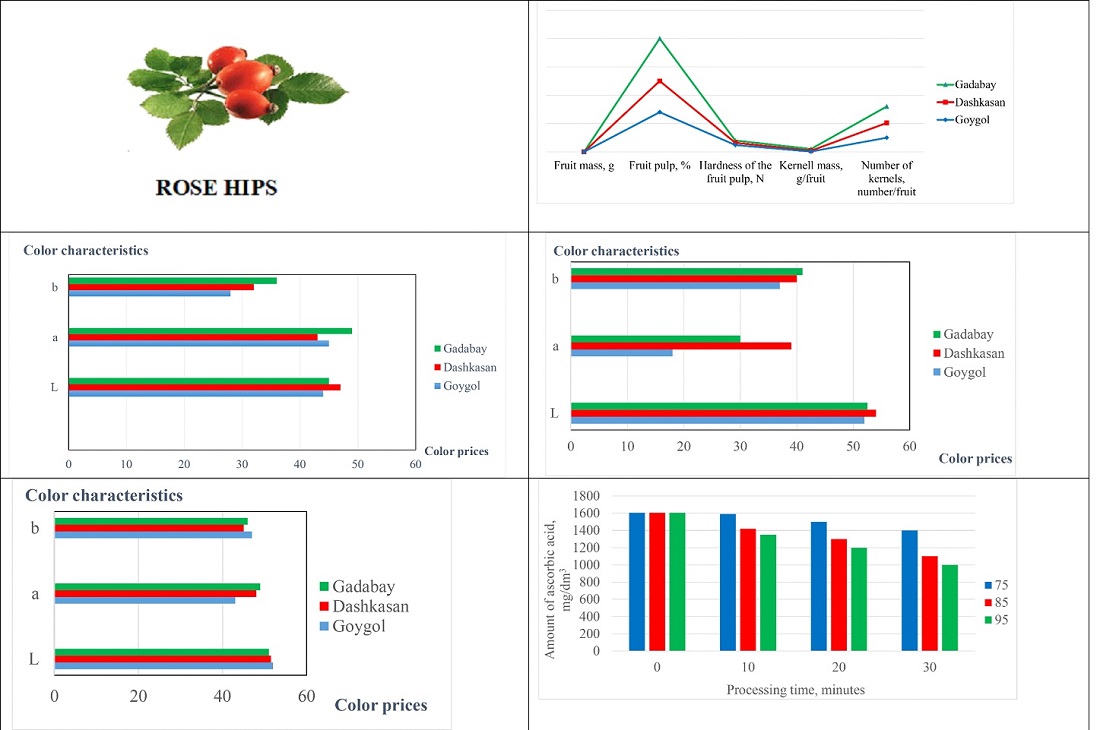Ідентифікація впливу умов дозрівання на врожайність плодів шипшини та продукти їх переробки
DOI:
https://doi.org/10.15587/1729-4061.2024.309597Ключові слова:
шипшина, м'якоть плодів, значення кольору, нектар, гідроксиметилфурфурол, антиоксидантні властивості, аскорбінова кислота, мінералиАнотація
Дикорослі плоди шипшини, м'якоть, напій, нектар, а також технологічні методи і засоби взяті як об'єкт дослідження.
Плоди шипшини мають яскраво-червоний колір та багатий хімічний склад, що робить їх дуже важливою сировиною для промисловості. Однак недостатнє дослідження сповільнює цю роботу і робить використання сировини неефективним. З урахуванням цього, метою було вивчення механічних та технологічних характеристик плодів, які вважаються важливими для промислової переробки.
Встановлено вплив умов дозрівання на механічні, фізичні та хімічні властивості плодів шипшини, а також вплив методів обробки, особливо гарячої обробки, на якість продукту.
Дослідження показали, що відсоток вирощування плодів у Дашкесанському районі був найнижчим, а найвищим – у Гедабейському районі, при цьому Гойгельський район зайняв проміжну позицію. Твердість плодів, вирощених у Дашкесанському районі, становила 6,41 Н, у Гедабейському районі – 5,56 Н, а в Гойгельському районі – 5,47 Н. Цей показник відіграє важливу роль у зберіганні та переробці плодів. Внаслідок обробки кількість сухих речовин у плодах, м'якоті та напої трохи збільшилася, титруємі кислоти, аскорбінова кислота та рН зменшилися. Було виявлено збільшення загальної кількості фенольних сполук під час початкової теплової обробки сировини, і було зазначено, що їх кількість значно менша у м'якоті та напої. Гаряча обробка мала знижувальний ефект на кількість аскорбінової кислоти, яка вважається одним з основних компонентів показників у плодах. Отримані результати можуть бути використані в індивідуальних сімейних господарствах та у харчовій промисловості
Посилання
- Koczka, N., Stefanovits-Bányai, É., Ombódi, A. (2018). Total Polyphenol Content and Antioxidant Capacity of Rosehips of Some Rosa Species. Medicines, 5 (3), 84. https://doi.org/10.3390/medicines5030084
- Peña, F., Valencia, S., Tereucán, G., Nahuelcura, J., Jiménez-Aspee, F., Cornejo, P., Ruiz, A. (2023). Bioactive Compounds and Antioxidant Activity in the Fruit of Rosehip (Rosa canina L. and Rosa rubiginosa L.). Molecules, 28 (8), 3544. https://doi.org/10.3390/molecules28083544
- Fascella, G., D’Angiolillo, F., Mammano, M. M., Amenta, M., Romeo, F. V., Rapisarda, P., Ballistreri, G. (2019). Bioactive compounds and antioxidant activity of four rose hip species from spontaneous Sicilian flora. Food Chemistry, 289, 56–64. https://doi.org/10.1016/j.foodchem.2019.02.127
- Bozhuyuk, M. R., Ercisli, S., Karatas, N., Ekiert, H., Elansary, H. O., Szopa, A. (2021). Morphological and Biochemical Diversity in Fruits of Unsprayed Rosa canina and Rosa dumalis Ecotypes Found in Different Agroecological Conditions. Sustainability, 13 (14), 8060. https://doi.org/10.3390/su13148060
- Ergün, F., Yağcı, M. (2024). Relationship between vitamin and antioxidant activities of rosehip species grown in the same ecological conditions. The Journal of Animal and Plant Sciences, 34 (2). https://doi.org/10.36899/japs.2024.2.0722
- Yildiz, O., Alpaslan, M. (2012). Properties of Rose Hip Marmalades. Food Technology and Biotechnology, 50 (1), 98–106. Available at: https://www.researchgate.net/publication/260006200_Properties_of_Rose_Hip_Marmalades
- Gurbuz, B. (2021). Production of probiotic yogurt enriched with rosehip seed powder. Tekirdag Namık Kemal University, 80.
- Mammadova, S. M., Fataliyev, H. K., Gadimova, N. S., Aliyeva, G. R., Tagiyev, A. T., Baloglanova, K. V. (2020). Production of functional products using grape processing residuals. Food Science and Technology, 40 (2), 422–428. https://doi.org/10.1590/fst.30419
- Ghendov-Mosanu, A., Cristea, E., Patras, A., Sturza, R., Niculaua, M. (2020). Rose Hips, a Valuable Source of Antioxidants to Improve Gingerbread Characteristics. Molecules, 25 (23), 5659. https://doi.org/10.3390/molecules25235659
- Gadimova, N., Fataliyev, H., Heydarov, E., Lezgiyev, Y., Isgandarova, S. (2023). Development of a model and optimization of the interaction of factors in the grain malting process and its application in the production of functional beverages. Eastern-European Journal of Enterprise Technologies, 5 (11 (125)), 43–56. https://doi.org/10.15587/1729-4061.2023.289421
- Gadimova, N., Fataliyev, H., Allahverdiyeva, Z., Musayev, T., Akhundova, N., Babashli, A. (2022). Obtaining and investigation of the chemical composition of powdered malt and polymalt extracts for application in the production of non-alcoholic functional beverages. Eastern-European Journal of Enterprise Technologies, 5 (11 (119)), 66–74. https://doi.org/10.15587/1729-4061.2022.265762
- Liaudanskas, M., Noreikienė, I., Zymonė, K., Juodytė, R., Žvikas, V., Janulis, V. (2021). Composition and Antioxidant Activity of Phenolic Compounds in Fruit of the Genus Rosa L. Antioxidants, 10 (4), 545. https://doi.org/10.3390/antiox10040545
- Murathan, Z., Zarifikhosroshahi, M., Kafkas, E., Sevindik, E. (2016). Characterization of bioactive compounds in rosehip species from East Anatolia region of Turkey. Italian Journal of Food Science, 28, 314–325. Available at: https://www.itjfs.com/index.php/ijfs/article/view/198/pdf_16
- Pashazadeh, H., Ali Redha, A., Koca, I. (2024). Effect of convective drying on phenolic acid, flavonoid and anthocyanin content, texture and microstructure of black rosehip fruit. Journal of Food Composition and Analysis, 125, 105738. https://doi.org/10.1016/j.jfca.2023.105738

##submission.downloads##
Опубліковано
Як цитувати
Номер
Розділ
Ліцензія
Авторське право (c) 2024 Hasil Fataliyev, Simuzar Isgandarova, Natavan Gadimova, Aynur Mammadova, Mehman Ismailov, Muhammad Mammadzade

Ця робота ліцензується відповідно до Creative Commons Attribution 4.0 International License.
Закріплення та умови передачі авторських прав (ідентифікація авторства) здійснюється у Ліцензійному договорі. Зокрема, автори залишають за собою право на авторство свого рукопису та передають журналу право першої публікації цієї роботи на умовах ліцензії Creative Commons CC BY. При цьому вони мають право укладати самостійно додаткові угоди, що стосуються неексклюзивного поширення роботи у тому вигляді, в якому вона була опублікована цим журналом, але за умови збереження посилання на першу публікацію статті в цьому журналі.
Ліцензійний договір – це документ, в якому автор гарантує, що володіє усіма авторськими правами на твір (рукопис, статтю, тощо).
Автори, підписуючи Ліцензійний договір з ПП «ТЕХНОЛОГІЧНИЙ ЦЕНТР», мають усі права на подальше використання свого твору за умови посилання на наше видання, в якому твір опублікований. Відповідно до умов Ліцензійного договору, Видавець ПП «ТЕХНОЛОГІЧНИЙ ЦЕНТР» не забирає ваші авторські права та отримує від авторів дозвіл на використання та розповсюдження публікації через світові наукові ресурси (власні електронні ресурси, наукометричні бази даних, репозитарії, бібліотеки тощо).
За відсутності підписаного Ліцензійного договору або за відсутністю вказаних в цьому договорі ідентифікаторів, що дають змогу ідентифікувати особу автора, редакція не має права працювати з рукописом.
Важливо пам’ятати, що існує і інший тип угоди між авторами та видавцями – коли авторські права передаються від авторів до видавця. В такому разі автори втрачають права власності на свій твір та не можуть його використовувати в будь-який спосіб.










